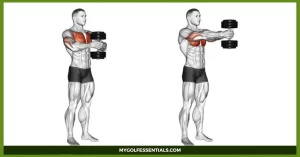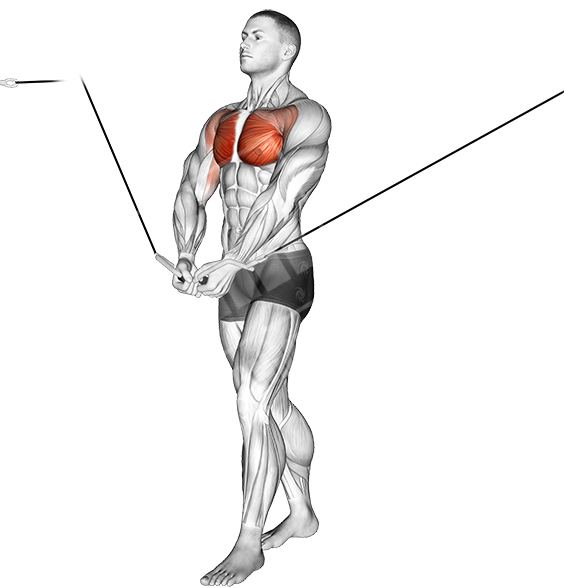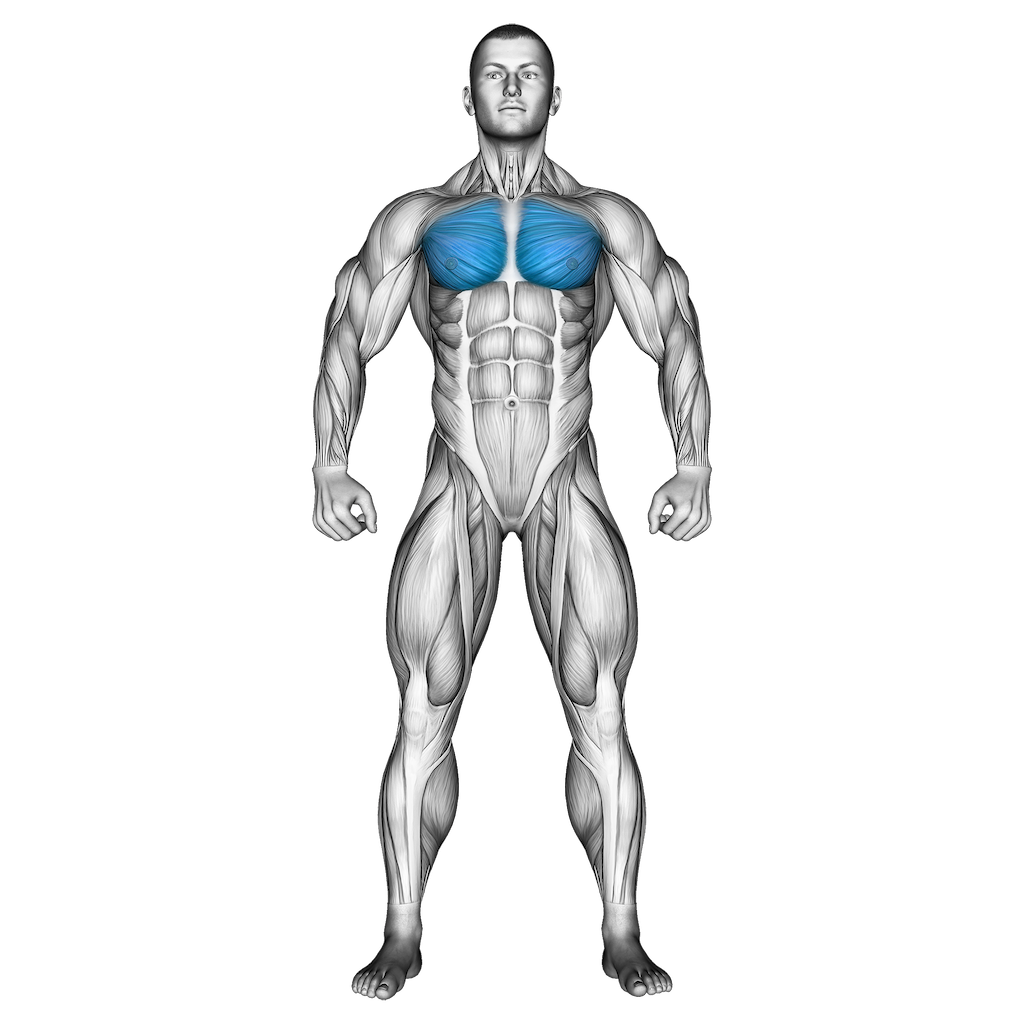
Do you ever feel like you lack motivation when it comes to working out? It can be not easy to find a workout routine that fits your needs while also pushing yourself outside of your comfort zone and transforming your body. With this in mind, if you want to give chest training a shot, then check out this dumbbell chest workout: an intense but effective program designed specifically for those looking for a challenge and ready to achieve their fitness goals.
Not only will this program improve your physical strength in the pecs, upper back, and triceps muscles, but it’ll also provide mental clarity along with increased energy levels so you’ll be ready for any activity life throws at you.
Overview of Dumbbell Chest Workout
Dumbbell squeeze press chest workouts are an excellent way to build strength and muscle mass in the pectoral region. Not only do they target the larger muscles in the chest, but they also engage the supporting muscle groups such as the triceps and deltoids. This makes dumbbell chest workouts a comprehensive and effective strategy for overall upper-body conditioning.
The versatility of dumbbells allows for a range of exercises, from the classic bench press to floor press, dumbbell flyes to dumbbell pullovers, all targeting different areas of the chest. Whether you’re a beginner or an experienced gym-goer, incorporating dumbbell chest workouts into your routine can yield significant benefits.
Benefits of strength training with dumbbells
Strength training with dumbbells presents several notable benefits. First, it helps to build muscle mass, which in turn speeds up your metabolic rate, leading to a higher calorie burn even when you are not exercising. Dumbbell chest workouts target multiple muscle groups at once, offering a comprehensive upper-body workout.
The versatility of dumbbells allows for a wide range of exercises, making your workout adaptable and dynamic. Furthermore, the use of dumbbells can lead to improved muscle endurance and increased muscle tone, enhancing your overall physique. Lastly, but certainly not least, strength training with dumbbells can bolster bone strength, promoting overall health and mitigating the risk of injury.
Step-by-step explanation of how to perform each exercise safely and effectively
- Bench Press: Start by sitting on a flat bench with a dumbbell in each hand resting on your lap. Carefully lay back on the bench, bringing the dumbbells to the sides of your chest. Aim for your elbows to form a 90-degree angle. Push the dumbbells up, fully extending your arms. Lower the dumbbells back to the starting position, repeating the process for your desired number of reps.
- Incline Dumbbell Press: Set up an adjustable bench to a 30-45-degree incline. Follow the same steps as the bench press but with the bench on an incline. This will target the upper part of your chest more.
- Dumbbell Flyes: Begin in the same starting position as the bench press. However, instead of pressing the dumbbells, lower them out to your sides until you feel a stretch in your chest. Maintain a slight bend in your elbows to prevent strain on your joints. Bring the dumbbells back together at the top, mimicking the arc of a bird flapping its wings.
- Decline Dumbbell Press: Set up an adjustable bench to a 30-45 degree decline. Follow the same steps as the bench press but with the bench on a decline. This will target the lower part of your chest more.
Tips for ensuring good form while doing each exercise
- Flat Dumbbell Press: It’s crucial to keep your chest out and back flat against the bench while performing this exercise. The dumbbells should move directly upwards and downwards in a controlled manner. Avoid locking your elbows at the top of the lift.
- Incline Dumbbell Press: Set your bench to an incline of about 30-45 degrees. Similar to the flat dumbbell press, ensure your back is flat against the bench. Your arms should form a 90-degree angle at the bottom of the movement, with the dumbbells lining up with your chest, not your shoulders.
- Dumbbell Flys: Maintaining a slight bend in your elbows, lower the dumbbells out to the sides until you feel a stretch in your chest. Remember to squeeze your pecs as you bring the weights back to the starting position.
Recommended reps and sets for maximal results
For optimal chest muscle development, we recommend a mix of both low and high-rep ranges across different exercises. Begin with a flat bench dumbbell press, performing 4 sets of 6-8 reps for strength building. Follow this with an incline dumbbell press, where you should execute 3 sets of 12 reps to engage the upper chest.
Wrap up with a dumbbell fly, carrying out 3 sets of 15 reps to achieve muscle exhaustion and promote growth. Remember to rest for 60-90 seconds between sets to allow adequate recovery. This mix of low and high rep ranges stimulates muscle growth effectively while ensuring you maintain proper form.
What muscles make up your chest
Sample dumbbell chest workouts comprises several critical muscles that aid in our daily activities. The most prominent is the pectoralis major. This muscle is primarily responsible for raising your arm in front of you, lowering your arm to the side, and rotating your arm inward.
Beneath the pectoralis major, you’ll find the pectoralis minor, a smaller yet equally important muscle that plays a crucial role in stabilizing the shoulder blade. Finally, there’s the serratus anterior, a muscle located deep under the pectorals on the lateral surfaces of the rib cage.
The serratus anterior is responsible for pulling your shoulder blades forward, enabling you to reach in front of you. These muscles can be effectively targeted with a dedicated dumbbell chest workout, enhancing not only aesthetics but also functionality.
Dumbbell Chest Press
The Dumbbell Chest Press is a fundamental yet profoundly effective movement that fitness enthusiasts universally embrace. While its primary aim is to target the major muscles in your chest, it simultaneously trains your shoulders and, when executed with precision, your back as well. This makes it an incredibly efficient exercise for upper body strengthening.
To perform this exercise, you will need two moderately heavy dumbbells. Please place them in front of your weight bench and sit down. Pick up the dumbbells and gently recline onto the bench until you’re lying flat. Position your arms so they form a right angle, with your elbow slightly beneath your shoulder level, your wrists in a neutral position, and your knuckles facing the wall behind you.
Engaging your chest muscles, push the weights into the air, fully extending your arms. Aim to align the weights slightly ahead of your shoulders, directly above your sternum (around the “nipple line”), to prevent any undue stress on your shoulder joint. Gradually return the weights to the starting position, drawing your shoulder blades together as you do so.
It would be best if you aimed for a set of 10-12 repetitions before taking a rest. If you can complete more repetitions, consider using heavier weights for your next set.
To add an element of variation to this exercise, consider alternating between your right and left arm or performing the exercise unilaterally – completing a set of repetitions with one arm and then switching to the other. If you don’t have access to a bench, you can perform the exercise lying on a mat instead.
Dumbbell Chest Fly
The Dumbbell Chest Fly is an excellent exercise that targets all the major muscles in the chest. It’s a go-to for many fitness enthusiasts wanting to build strength and definition. To execute this workout, start by selecting two dumbbells of light to moderate weight. Position yourself on a weight bench, pick up the dumbbells, and gradually lower your body until you’re lying flat. Now, lift the dumbbells above you so they’re aligned over your sternum, palms facing each other.
Maintain a slight bend in your elbows as you slowly drop the weights to your sides, locking your arm position, stretching out your chest, and pulling your shoulder blades back. When you reach the limit of your range, engage your chest muscles to bring the weights back to their initial position. Aim for 10-12 reps until you reach muscle fatigue on the last one.
To keep things interesting, you could alternate between your left and right arm or complete all reps on one side before switching. If you don’t have a weight bench, you can perform this exercise on a mat. Remember, it’s essential to maintain proper form throughout this workout to prevent injury and ensure maximum results.
Dumbbell Pullover
The dumbbell pullover is a dynamic chest workout that engages not only the pectoral muscles but also the lats, triceps, and deltoids. Despite its reputation as a back exercise, it can be an effective way to build chest strength.
To do the dumbbell pullover, first, select a dumbbell with a moderate weight. Lie down slowly on a weight bench, holding the dumbbell vertically by one end over your sternum. Keep your feet firmly planted on the ground, depress your shoulder blades, and lower the dumbbell slowly past your head.
When you’ve hit your maximum extension, engage your chest muscles to return the dumbbell to its starting position. Perform 10-12 repetitions, aiming for muscle fatigue by the end of your set.
If you don’t have a weight bench at your disposal, the dumbbell pullover can be performed on the floor, but keep in mind that this might limit your range of motion.
Dumbbell Svend Press
Linger in a fitness center long enough, and you’ll undoubtedly spot someone executing a Svend press. This exercise is often used with plates as a prelude to bench pressing, but it can be a standalone workout with a pair of dumbbells. To execute the Svend press, choose two dumbbells that are light to moderately heavy. Grasp them vertically by the handles and press them together.
Stand with your feet roughly hip-width apart and activate your core. Draw the dumbbells close to your chest, then extend your arms and push the dumbbells away from you in a straight line, ensuring they remain tightly pressed together. Repeat this action for 10-12 reps, making sure your muscles tire out on the final rep.
To diversify your Svend press, push the dumbbells away from you at an angle, both upwardly and downwardly. If your dumbbells are circular or if you only have one, the Svend press can be performed with a single dumbbell: hold it horizontally and apply pressure on both ends with your hands.
Standing Cross-Body Dumbbell Raise
The Standing Cross Body Dumbbell Raise is an exceptional exercise that targets the lower part of your chest, often a challenging area to define. To begin, select a dumbbell of light to moderate weight that you can comfortably lift. Stand up straight with your feet placed about hip-width apart, ensuring your core is engaged for stability.
With the dumbbell in your right hand, slightly bend your elbow. Adopting an underhand grip, slowly lift the weight towards your left shoulder while contracting the right pectoral muscle. Carefully lower the dumbbell back to the starting point.
Aim for a set of 10-12 repetitions, then switch to the left arm. This workout is not only great for enhancing muscle symmetry but also boosts overall strength and endurance when done regularly.
Crush Grip Dumbbell Press
The Crush Grip Dumbbell Press is an innovative and challenging exercise that targets and effectively engages the chest muscles. Much akin to the Svend press, it intensifies a regular press motion by enforcing a consistent contraction of the pectoral muscles throughout the exercise.
You can execute this workout by first obtaining two moderately heavy dumbbells and situating them before you. Proceed to occupy a seat on a weight bench and lift the dumbbells. Gradually recline to a lying position while holding the dumbbells vertically, aligning both ends of each bell with your sternum. Ensure to engage and “crush” the dumbbells together using your chest muscles as you press both weights toward the ceiling.
Gently descend the weights back to the initial position, all the while maintaining pressure on the dumbbells. Aim to achieve 10-12 repetitions until your muscles are tired. In the absence of a weight bench, you can perform this exercise on a mat.
Furthermore, if you’re working with a single dumbbell or possess circular as opposed to hexagonal dumbbells, utilize a single weight for the crushing press. Hold the weight horizontally and apply pressure on each end with your hands.
Decline Dumbbell Chest Press
A twist on the standard chest press, the alternate decline dumbbell press specifically targets the lower chest muscles. To perform this exercise, first secure two moderately heavy dumbbells. Position yourself on a decline weight bench, securing your feet in the leg braces, and slowly lay back.
Aim the dumbbells straight above your sternum, with your knuckles turned towards the wall behind you. Ensure your shoulder blades are retracted, then gently lower the dumbbells to your sides, keeping your elbows slightly lower than your shoulders to create a right angle with your arms.
Powerfully press the dumbbells back up to the starting position. Repeat this movement for 10-12 reps, pushing until you observe muscle fatigue. Depending on the weight used in the best dumbbell chest workouts, you may require a spotter to hand you the dumbbells before you begin and to take them after you’ve completed your set.
To add variety to your workout, alternate between your left and right arms or perform a full set with one arm before switching to the other. This alternate decline dumbbell chest press can amplify the focus on your lower chest muscles and enhance your chest workout routine.
Incline Dumbbell Chest Press
The Incline Dumbbell Chest Press exercise is a fantastic variant of the traditional chest press, specifically designed to target the upper pectorals. To execute this, first, pick two reasonably heavy dumbbells and position them before you.
Adjust your weight barbell bench press to an angle that’s halfway between completely flat and completely upright. Sit on the bench, grasp the weights, and gently lower them onto the bench. Align the weights with your shoulders, ensuring your knuckles are pointed towards the wall behind you. Push the weights towards the ceiling, keeping them in line with your upper chest.
Lower the weights back to the starting position. Perform dumbbell exercises for a set of 10-12 repetitions, aiming for muscle fatigue on your final rep. For an additional challenge and variety, alternate between your left and right arm, or finish an entire set with one arm before switching to the other.
FAQs
How many reps should I do for the Dumbbell Chest Workouts?
For most dumbbell chest workouts, aim for 10-12 repetitions until you observe muscle fatigue. It is important to remember that everyone’s body is different, and the number of reps needed may vary between individuals. Monitor your progress and adjust the repetitions accordingly.
Is there an alternative to dumbbell chest workouts?
If you don’t have access to dumbbells, a great alternative is bodyweight exercises such as push-ups or band chest presses. Alternatively, you can use resistance bands for resistance training. However, these workouts may not be as effective when it comes to targeting specific muscles in the chest.
What is a Standing Cross Body Dumbbell Raise?
The Standing Cross Body Dumbbell Raise is an isolation exercise focused on the muscles in your shoulders and arms. It basically consists of raising a dumbbell from one side to the other with your arms crossed over your chest.
What is the purpose of Crush Grip?
The Crush Grip Dumbbell Press is an innovative and challenging exercise that targets the chest muscles. Much akin to the Svend press, it intensifies a regular press motion by enforcing a consistent contraction of the pectoral muscles throughout the exercise.
Is it okay to perform dumbbell chest workouts without a weight bench?
Yes, you can still perform the dumbbell chest exercises and dumbbell bench press without a weight bench. You can do them on a mat or in an open space such as your living room or backyard. Additionally, depending on the type of dumbbells you have, you can opt to hold a single weight for the crush press exercise.
Conclusion
I hope this article has given you a greater understanding of how to safely and effectively perform dumbbell chest exercises. Whether you’re looking to strengthen your core, build muscle mass, or tone up, these workouts can help you achieve your goals.
With regular practice and healthy eating habits, you’ll be well on your way to a leaner and stronger physique in no time. Be sure to monitor your progress and consult a medical professional if you experience any pain or discomfort during the exercises.



